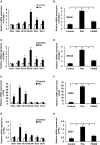FK506 Attenuated Pilocarpine-Induced Epilepsy by Reducing Inflammation in Rats
- PMID: 31572289
- PMCID: PMC6751399
- DOI: 10.3389/fneur.2019.00971
FK506 Attenuated Pilocarpine-Induced Epilepsy by Reducing Inflammation in Rats
Abstract
Background: The status epilepticus (SE) is accompanied by a local inflammatory response and many oxygen free radicals. FK506 is an effective immunosuppressive agent with neuroprotective and neurotrophic effects, however, whether it can inhibit the inflammatory response and attenuate epilepsy remains unclear. Objective: This study aims to clarify the effect of FK506 on inflammatory response in rats with epilepsy. Methods: A total of 180 rats were randomly and equally divided into the control group, epilepsy group, and FK506 group. The rat SE model in the epilepsy group and FK506 group was induced by lithium chloride combined with pilocarpine. In the FK506 group, FK506 was given before the injection of pilocarpine. The control group was given the same volume of saline. Then the effect of FK506 on epilepsy in rats and the changes of inflammatory factors and free radicals in hippocampus were examined using hematoxylin and eosin (HE) staining, immunohistochemistry, quantitative real-time polymerase chain reaction (qRT-PCR), and western blotting. Results: FK506 ameliorated the course of pilocarpine-induced epilepsy and the neuronal loss in the rat hippocampus after SE. FK506 reduced the increased content of nitric oxide (NO), superoxide dismutase (SOD), and malondialdehyde (MDA) in the hippocampus after SE. Besides, FK506 also significantly reduced the levels of factors involved in inflammatory response such as vascular cell adhesion molecule-1 (VCAM-1), intercellular adhesion molecule-1 (ICAM-1), tumor necrosis factor-α (TNF-α), and Protein Kinase C δ (PKCδ) that rise after epilepsy. Conclusion: FK506 ameliorated the course of pilocarpine-induced epilepsy, significantly reduced free radical content, and inhibited the expression of inflammatory factors, which provided a theoretical basis for the application of FK506 in the treatment of epilepsy.
Keywords: FK506; inflammatory response; neuroprotective; radical content; status epilepsy.
Copyright © 2019 Wang, Si, Li, Lu, Pan and Liu.
Figures





Similar articles
-
Tacrolimus protects hippocampal neurons of rats with status epilepticus through suppressing oxidative stress and inhibiting mitochondrial pathway of apoptosis.Brain Res. 2019 Jul 15;1715:176-181. doi: 10.1016/j.brainres.2019.02.031. Epub 2019 Mar 1. Brain Res. 2019. PMID: 30831086
-
The spatiotemporal expression changes of CB2R in the hippocampus of rats following pilocarpine-induced status epilepticus.Epilepsy Res. 2018 Dec;148:8-16. doi: 10.1016/j.eplepsyres.2018.10.002. Epub 2018 Oct 9. Epilepsy Res. 2018. PMID: 30317115
-
Effect of adenovirus-mediated overexpression of PTEN on brain oxidative damage and neuroinflammation in a rat kindling model of epilepsy.Chin Med J (Engl). 2019 Nov 5;132(21):2628-2635. doi: 10.1097/CM9.0000000000000496. Chin Med J (Engl). 2019. PMID: 31658159 Free PMC article.
-
The Neuroprotective Effect of Astaxanthin on Pilocarpine-Induced Status Epilepticus in Rats.Front Cell Neurosci. 2019 Mar 29;13:123. doi: 10.3389/fncel.2019.00123. eCollection 2019. Front Cell Neurosci. 2019. PMID: 30983975 Free PMC article.
-
The effects of calcineurin inhibitor FK506 on actin cytoskeleton, neuronal survival and glial reactions after pilocarpine-induced status epilepticus in mice.Epilepsy Res. 2018 Feb;140:138-147. doi: 10.1016/j.eplepsyres.2018.01.007. Epub 2018 Jan 10. Epilepsy Res. 2018. PMID: 29358156
Cited by
-
The Therapeutic Effects of Oral Intake of Hydrogen Rich Water on Cutaneous Wound Healing in Dogs.Vet Sci. 2021 Nov 4;8(11):264. doi: 10.3390/vetsci8110264. Vet Sci. 2021. PMID: 34822637 Free PMC article.
-
Immunosuppressant Tacrolimus Treatment Delays Acute Seizure Occurrence, Reduces Elevated Oxidative Stress, and Reverses PGF2α Burst in the Brain of PTZ-Treated Rats.Neurochem Res. 2023 Jun;48(6):1971-1980. doi: 10.1007/s11064-023-03885-0. Epub 2023 Feb 13. Neurochem Res. 2023. PMID: 36780043
-
The Role of NLRP3 and IL-1β in Refractory Epilepsy Brain Injury.Front Neurol. 2020 Feb 7;10:1418. doi: 10.3389/fneur.2019.01418. eCollection 2019. Front Neurol. 2020. PMID: 32116990 Free PMC article.
-
TRPM7 kinase mediates hypomagnesemia-induced seizure-related death.Sci Rep. 2023 May 15;13(1):7855. doi: 10.1038/s41598-023-34789-2. Sci Rep. 2023. PMID: 37188671 Free PMC article.
-
Autophagy and autophagy signaling in Epilepsy: possible role of autophagy activator.Mol Med. 2023 Oct 25;29(1):142. doi: 10.1186/s10020-023-00742-2. Mol Med. 2023. PMID: 37880579 Free PMC article. Review.
References
-
- Rodriguez-Alvarez N, Jimenez-Mateos EM, Dunleavy M, Waddington JL, Boylan GB, Henshall DC. Effects of hypoxia-induced neonatal seizures on acute hippocampal injury and later-life seizure susceptibility and anxiety-related behavior in mice. Neurobiol Dis. (2015) 83:100–14. 10.1016/j.nbd.2015.08.023 - DOI - PubMed
LinkOut - more resources
Full Text Sources
Miscellaneous

